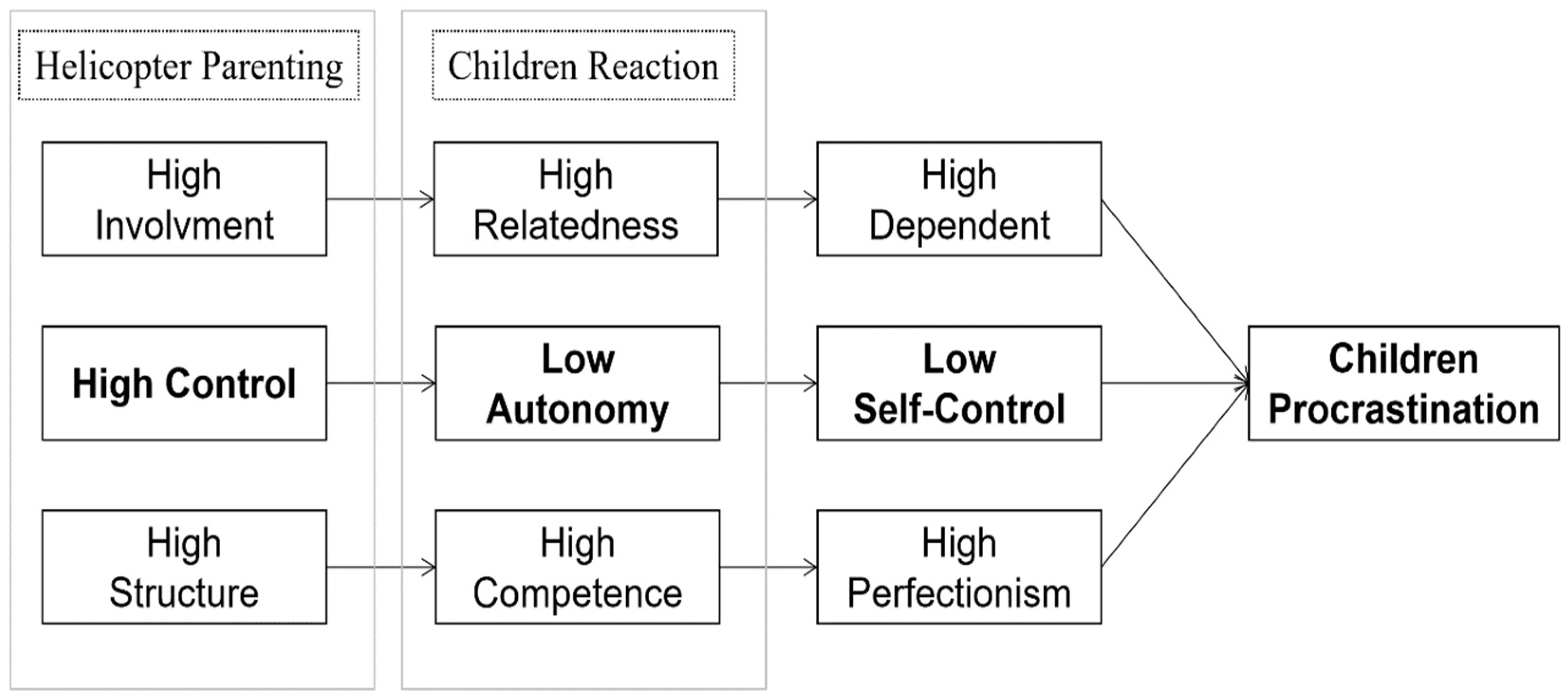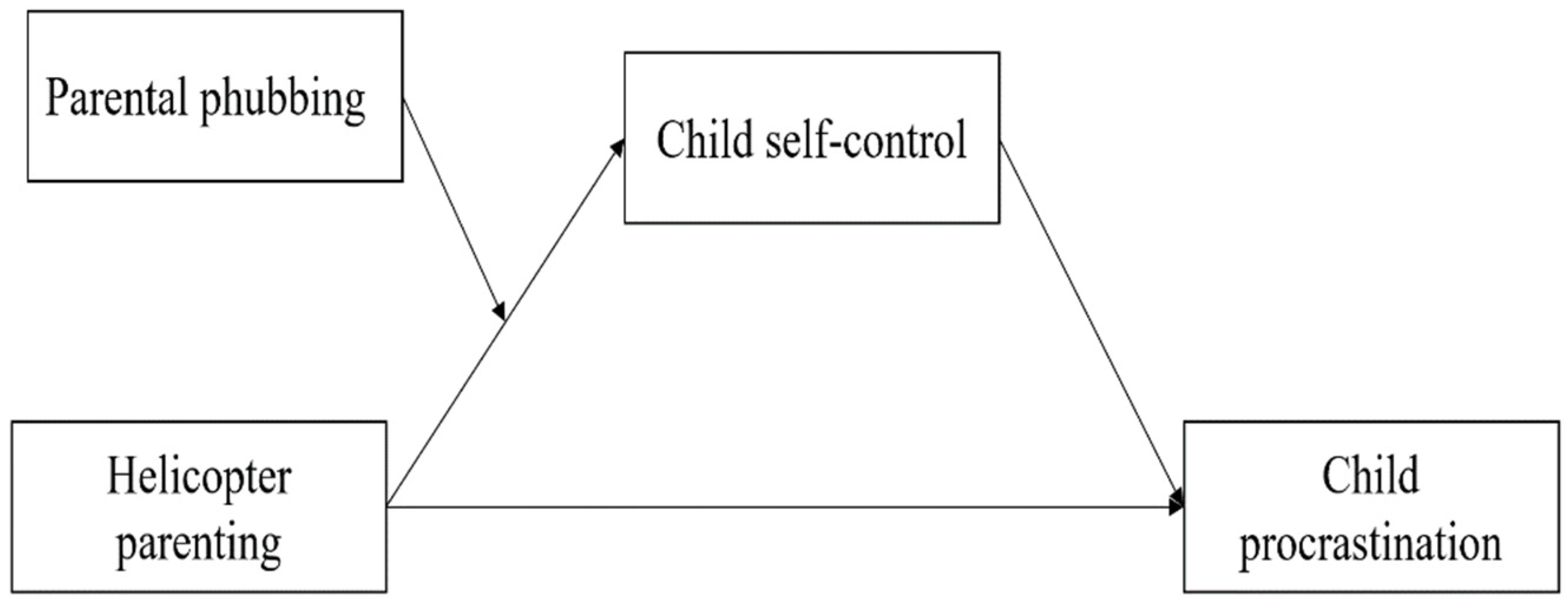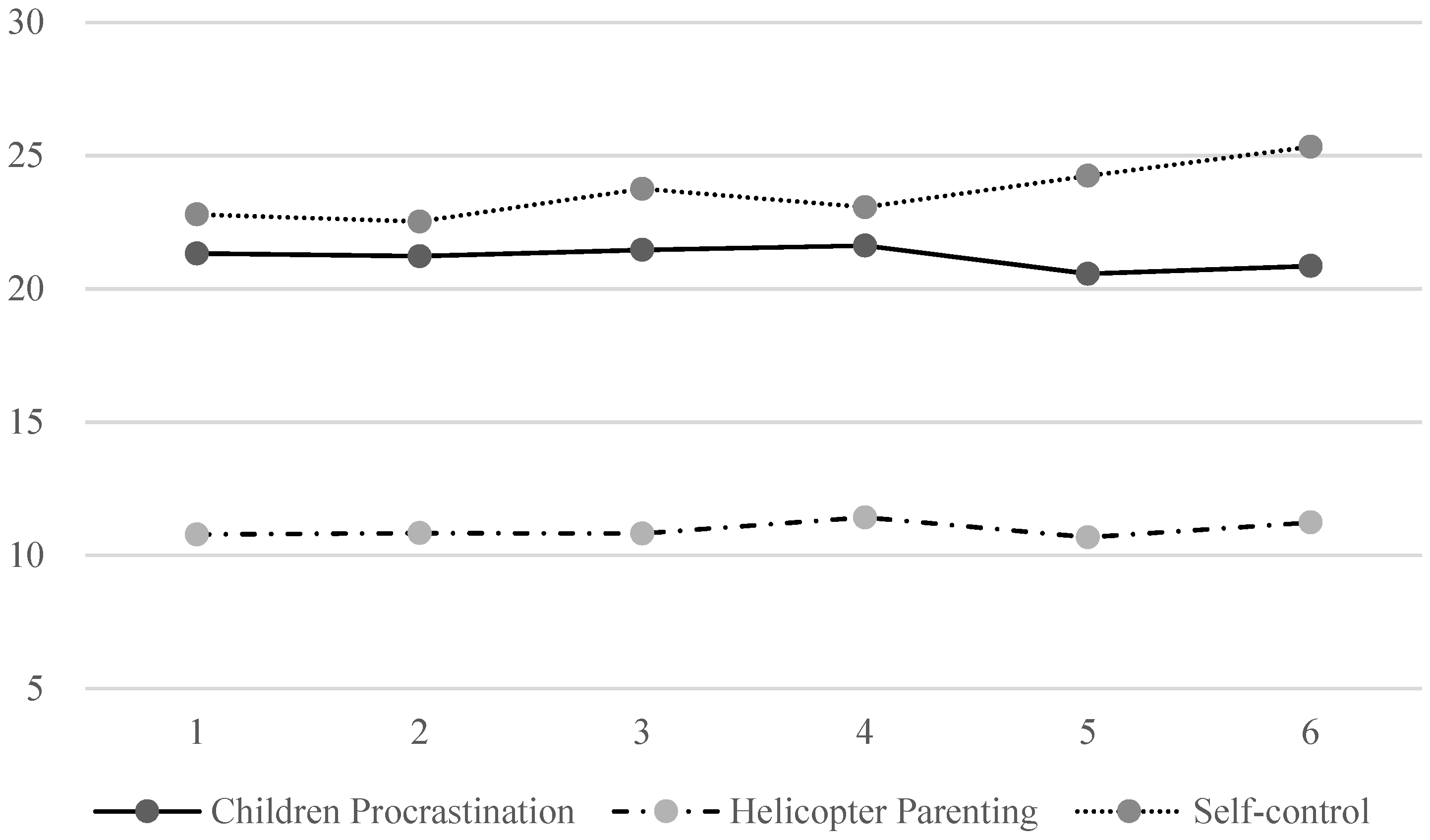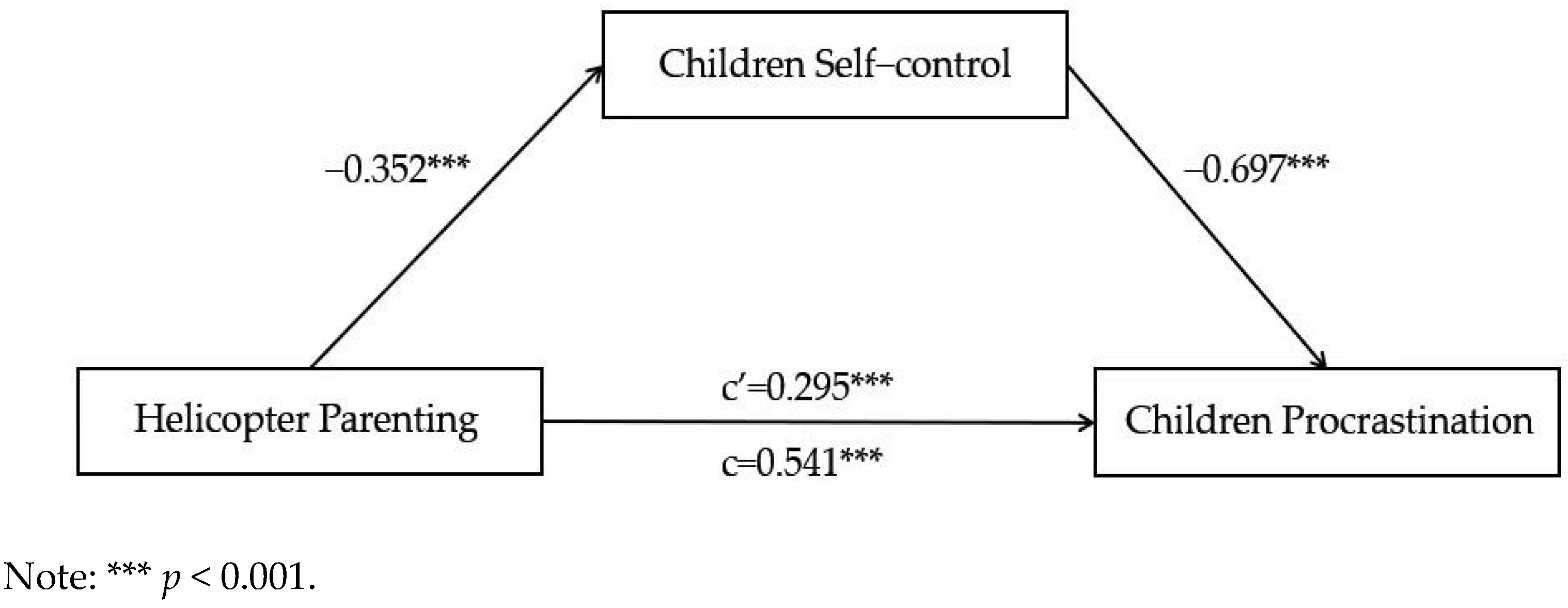Relationship between Helicopter Parenting and Chinese Elementary School Child Procrastination: A Mediated Moderation Model
Abstract
1. Introduction
1.1. Helicopter Parenting and Child Procrastination
1.2. Mediating Role of Children’s Self-Control
1.3. Moderating Role of Parental Phubbing Behavior
2. Research Methodology
2.1. Participants
2.2. Research Tools
2.3. Data Analysis
3. Results
3.1. Common Method Bias Detection
3.2. Means, Standard Deviations, and Correlations of the Variables
3.3. Assessing the Mediating Effect of Child Self-Control on the Relationship between Helicopter Parenting and Child Procrastination
3.4. Moderating Role of Parental Smartphone Use on the Relationships between Helicopter Parenting, Child Self-Control, and Child Procrastination
4. Discussion
4.1. Mediating Role of Child Self-Control on the Relationship between Helicopter Parenting and Child Procrastination
4.2. Moderating Role of Parental Phubbing Behavior
5. Conclusions, Significance, and Limitations of the Study
Author Contributions
Funding
Institutional Review Board Statement
Informed Consent Statement
Data Availability Statement
Conflicts of Interest
References
- Ferrari, J.R.; O’Callghan, J.; Newbegin, I. Prevalence of Procrastination in the United States, United Kingdom, and Australia: Arousal and Avoidance Delays among Adults. N. Am. J. Psychol. 2005, 7, 1–6. Available online: http://www.researchgate.net/publication/276354186_Prevalence_of_Procrastination_in_the_United_States_United_Kingdom_and_Australia_Arousal_and_Avoidance_Delays_among_Adults (accessed on 16 May 2015).
- Esteban, R.C.; Ramírez, A. Procrastination and demographic characteristics associated with college students. Tehran Univ. Med. J. 2014, 72, 113–120. [Google Scholar] [CrossRef]
- Steel, P. The nature of procrastination: A meta-analytic and theoretical review of quintessential self-regulatory failure. Psychol. Bull. 2007, 133, 65–94. [Google Scholar] [CrossRef]
- Chu, A.; Choi, J. Rethinking procrastination: Positive effects of “active” procrastination behavior on attitudes and performance. J. Soc. Psychol. 2005, 145, 245–264. [Google Scholar] [CrossRef]
- Chen, X.; Lin, Y.; Liu, Q.X. The effect of technological interference on adolescent smartphone addiction: The role of core self-evaluation and psychological need network satisfaction. Psychol. Sci. 2020, 43, 355–362. [Google Scholar] [CrossRef]
- Chen, Z.; Zhang, R.; Xu, T.; Yang, Y.; Wang, J.; Feng, T. Emotional attitudes towards procrastination in people: A large-scale sentiment-focused crawling analysis. Comput. Hum. Behav. 2020, 110, 106391. [Google Scholar] [CrossRef]
- Procee, R.; Kamphorst, B.A.; Wissen, A.V.; Meyer, J.; Action, N.H.; Ethiek, L.W. A Formal Model of Procrastination. Benelux Conference on Artificial Intelligence. 2013. Available online: http://www.xueshufan.com/publication/1688060441 (accessed on 8 November 2013).
- Zhang, S.; Feng, T. Modeling procrastination: Asymmetric decisions to act between the present and the future. J. Exp. Psychol. Gen. 2019, 149, 311–322. [Google Scholar] [CrossRef] [PubMed]
- Jia, W.Y.; Yi, X.; Lin, H.X. Family, Together with School Cope with Children’s Cellphones. China Education Daily. 26 March 2021, p. 03. Available online: http://paper.jyb.cn/zgjyb/html/2021-03/26/content_592043.htm?div=-1 (accessed on 26 March 2021).
- Bandura, A. Social Cognitive Theory: An Agentic Perspective. Annu. Rev. Psychol. 2001, 52, 1–26. [Google Scholar] [CrossRef] [PubMed]
- Chen, Z.; Peiwei, L.; Zhang, C.; Feng, T. Brain Morphological Dynamics of Procrastination: The Crucial Role of the Self-Control, Emotional, and Episodic Prospection Network. Cereb. Cortex 2019, 30, 2834–2853. [Google Scholar] [CrossRef]
- Bridgett, D.J.; Burt, N.M.; Edwards, E.S.; Deater-Deckard, K. Intergenerational transmission of self-regulation: A multidisciplinary review and integrative conceptual framework. Psychol. Bull. 2015, 141, 602–654. [Google Scholar] [CrossRef]
- Feng, T.; Wang, X.; Su, T. Developmental cognitive mechanism and neural basis of procrastination. Adv. Psychol. Sci. 2022, 29, 586–596. [Google Scholar] [CrossRef]
- Ungar, M.; Ghazinour, M.; Richter, J. Annual Research Review: What is resilience within the social ecology of human development?: Resilience in the social ecology of human development. J. Child Psychol. Psychiatry 2013, 54, 348–366. [Google Scholar] [CrossRef]
- Garcia, F.; Serra, E.; Garcia, O.; Martinez, I.; Cruise, E. A Third Emerging Stage for the Current Digital Society? Optimal Parenting Styles in Spain, the United States, Germany, and Brazil. Int. J. Environ. Res. Public Health 2019, 16, 2333. [Google Scholar] [CrossRef] [PubMed]
- Zeynep, S.E.T. The mediating role of inflated sense of self and impulsivity in the relationship between helicopter parenting and psychological symptoms. Arch. Neuropsychiatry 2020, 57, 318–324. [Google Scholar] [CrossRef]
- Xia, Y.; Kong, F. Implications, effects and after-effects of helicopter parenting. Psychol. Sci. 2021, 3, 612. [Google Scholar]
- LeMoyne, T.; Buchanan, T. Does “hovering” matter? helicopter parenting and its effect on well-being. Sociol. Spectr. 2011, 31, 399–418. [Google Scholar] [CrossRef]
- Bradley-Geist, J.C.; Olson-Buchanan, J.B. Helicopter parents: An examination of the correlates of over-parenting of college students. Educ. Train. 2014, 56, 314–328. [Google Scholar] [CrossRef]
- Connell, J.P.; Wellborn, J.G. Competence, autonomy, and relatedness: A motivational analysis of self-system processes. In Self Processes and Development; Gunnar, M.R., Sroufe, L.A., Eds.; Lawrence Erlbaum Associates, Inc.: Mahwah, NJ, USA, 1991; pp. 43–77. [Google Scholar]
- Rickert, N.P.; Skinner, E.A. Parent and teacher warm involvement and student’s academic engagement: The mediating role of self-system processes. Br. J. Educ. Psychol. 2022, 92, e12470. [Google Scholar] [CrossRef]
- Onwuegbuzie, A.J. Academic Procrastinators and Perfectionistic Tendencies Among Graduate Students. J. Soc. Behav. Personal. 2000, 15, 103–109. [Google Scholar] [CrossRef]
- Fuentes, M.C.; García-Ros, R.; Pérez-González, F.; Sancerni, D. Effects of parenting styles on self-regulated learning and academic stress in Spanish adolescents. Int. J. Environ. Res. Public Health 2019, 16, 2778. [Google Scholar] [CrossRef]
- Zakeri, H.; Esfahani, B.N.; Razmjoee, M. Parenting styles and academic procrastination. Procedia—Soc. Behav. Sci. 2013, 84, 57–60. [Google Scholar] [CrossRef]
- Segrin, C.; Givertz, M.; Swaitkowski, P.; Montgomery, N. Overparenting is associated with child problems and a critical family environment. J. Child Fam. Stud. 2015, 24, 470–479. [Google Scholar] [CrossRef]
- Sirois, F.; Pychyl, T. Procrastination and the priority of short-term mood regulation: Consequences forfuture self. Soc. Personal. Psychol. Compass 2013, 7, 115–127. [Google Scholar] [CrossRef]
- Ridder, D.D.; Lensveltmulders, G.; Finkenauer, C.; Stok, F.M.; Baumeister, R.F. Taking stock of self-control: A meta-analysis of how trait self-control relates to a wide range of behaviors. Personal. Soc. Psychol. Rev. 2012, 16, 76–99. [Google Scholar] [CrossRef] [PubMed]
- Kim, J.; Hong, H.; Lee, J.; Hyun, M.-H. Effects of time perspective and self-control on procrastination and Internet addiction. J. Behav. Addict. 2017, 6, 229–236. [Google Scholar] [CrossRef] [PubMed]
- Przepiórka, A.; Błachnio, A.; Siu, N.Y.-F. The relationships between self-efficacy, self-control, chronotype, procrastination and sleep problems in young adults. Chronobiol. Int. 2019, 36, 1025–1035. [Google Scholar] [CrossRef] [PubMed]
- Wang, Y. The improvement of self-control group counseling on graduate students’ academic procrastination. Chin. J. Health Psychol. 2014, 22, 208–210. [Google Scholar] [CrossRef]
- Hu, Y.; Liu, P.; Guo, Y.; Feng, T. The neural substrates of procrastination: A voxel-based morphometrystudy. Brain Cogn. 2018, 121, 11–16. [Google Scholar] [CrossRef]
- Steel, P.; König, C.J. Integrating Theories of Motivation. Acad. Manag. Rev. 2006, 31, 889–913. [Google Scholar] [CrossRef]
- Strunk, K.K.; Cho, Y.; Steele, M.R.; Bridges, S.L. Development and validation of a 2×2 model of time-related academic behavior: Procrastination and timely engagement. Learn. Individ. Differ. 2013, 25, 35–44. [Google Scholar] [CrossRef]
- Cui, M.; Allen, J.W.; Fincham, F.D.; May, R.W.; Love, H. Helicopter parenting, self-regulatory processes, and alcohol use among female college students. J. Adult Dev. 2019, 26, 97–104. [Google Scholar] [CrossRef]
- Hong, P.; Cui, M. Helicopter Parenting and College Students’ Psychological Maladjustment: The Roleof Self-control and Living Arrangement. J. Child Fam. Stud. 2020, 29, 338–347. [Google Scholar] [CrossRef]
- Turner, L.A.; Faulk, R.D.; Garner, T. Helicopter parenting, authenticity, and depressive symptoms: A mediation model. J. Genet. Psychol. 2020, 181, 500–505. [Google Scholar] [CrossRef] [PubMed]
- Wang, J.; Lai, R.; Yang, A.; Yang, M.; Guo, Y. Helicopter parenting and depressive level among non-clinical Chinese college students: A moderated mediation model. J. Affect. Disord. 2021, 295, 522–529. [Google Scholar] [CrossRef] [PubMed]
- Atherton, O.E.; Lawson, K.M.; Robins, R.W. The development of effortful control from late childhod to young adulthood. J. Personal. Soc. Psychol. 2020, 119, 417. [Google Scholar] [CrossRef]
- Meldrum, R. Beyond parenting: An examination of the etiology of self-control. J. Crim. Justice 2008, 36, 244–251. [Google Scholar] [CrossRef]
- Hong, Z.; Li, N.; Li, D.; Li, J.; Li, B.; Xiong, W.; Lu, L.; Li, W.; Zhou, D. Telemedicine During the COVID-19 Pandemic: Experiences From Western China. J. Med. Internet Res. 2020, 22, e19577. [Google Scholar] [CrossRef]
- Kayis, A.R.; Satici, B.; Deniz, M.E.; Satici, S.A.; Griffiths, M.D. Fear of COVID-19, loneliness, smartphone addiction, and mental well-being among the Turkish general population: A serial mediation model. Behav. Inf. Technol. 2021, 41, 2484–2496. [Google Scholar] [CrossRef]
- Roberts, J.A.; David, M.E. My life has become a major distraction from my cell phone: Partner phubbing and relationship satisfaction among romantic partners. Comput. Hum. Behav. 2016, 54, 134–141. [Google Scholar] [CrossRef]
- Jiang, Q.-Y.; Wang, X.-C.; Liu, B.; Wang, P.-C.; Li, L. The effects of parental phubbing behavior on the psychological development of children and adolescents. Psychol. Dev. Educ. 2021, 37, 137–145. [Google Scholar] [CrossRef]
- Liu, W.-L.; Cai, T.S.; Zhu, H.; Lu, Y.; Ling, Y. The relationship between depression, anxiety, stress and emotional eating in adolescents: The mediating role of self-control. Chin. J. Clin. Psychol. 2016, 24, 841–843. [Google Scholar] [CrossRef]
- Zhang, Y.; Li, S.; Yu, G. Reliability test of the short version of the General Procrastination Scale in a Chinese college student population. Chin. J. Clin. Psychol. 2020, 3, 483–486. [Google Scholar] [CrossRef]
- Luo, T.; Cheng, L.M.; Qin, L.X.; Xiao, S. Reliability test of the Chinese version of the Short Form Self-Control Scale. Chin. J. Clin. Psychol. 2021, 29, 83–86. [Google Scholar] [CrossRef]
- Chen, H.; Wang, L.; Qiao, N.; Cao, Y.; Zhang, Y. Preliminary development of a smartphone addiction scale for adults. Chin. J. Clin. Psychol. 2017, 4, 645–649. [Google Scholar] [CrossRef]
- Hayes, A. Introduction to mediation, moderation, and conditional process analysis. J. Educ. Meas. 2013, 51, 335–337. [Google Scholar] [CrossRef]
- Zhou, H.; Long, L.R. A statistical test and control method for common method bias. Adv. Psychol. Sci. 2004, 6, 942–950. [Google Scholar]
- Zuo, X.-N.; He, Y.; Betzel, R.F.; Colcombe, S.; Sporns, O.; Milham, M.P. Human Connectomics across the Life Span. Trends Cogn. Sci. 2017, 21, 32–45. [Google Scholar] [CrossRef]
- Beutel, M.E.; Klein, E.M.; Aufenanger, S.; Brähler, E.; Dreier, M.; Müller, K.W.; Quiring, O.; Reinecke, L.; Shmutzer, G.; Stark, B.; et al. Procrastination, Distress and Life Satisfaction across the Age Range—A German Representative Community Study. PLoS ONE 2016, 11, e0148054. [Google Scholar] [CrossRef]
- Hong, J.C.; Hwang, M.Y.; Kuo, Y.C.; Hsu, W.Y. Parental monitoring and helicopter parenting relevant to vocational student’s procrastination and self-regulated learning. Learn. Individ. Differ. 2015, 42, 139–146. [Google Scholar] [CrossRef]
- Sang, B. Psychology of Child Development; Higher Education Press: Shanghai, China, 2013; p. 57. [Google Scholar]
- Liu, J.D.; Zhong, B.G.; Si, G.Y. Application of self-determination theory to a Chinese population. Adv. Psychol. Sci. 2013, 21, 1803. [Google Scholar] [CrossRef]
- Keshavarz, S.; Baharudin, R. Perceived parenting style of fathers and adolescents’ locus of control in a collectivist culture of Malaysia: The moderating role of fathers’ education. J. Genet. Psychol. 2013, 174, 253–270. [Google Scholar] [CrossRef] [PubMed]
- Pomerantz, E.M.; Moorman, E.A.; Litwack, S.D. The How, Whom, and Why of Parents’ Involvement in Children’s Academic Lives: More Is not Always Better. Rev. Educ. Res. 2007, 77, 373–410. Available online: http://www.jstor.org/stable/4624903 (accessed on 15 September 2007). [CrossRef]
- Lian, S.; Gong, J.; Yan, J.; Feng, Q.; Sun, X. The relationship between parental procrastination and children’s time management tendencies and academic procrastination: The protective role of children’s volitional control. Chin. J. Clin. Psychol. 2021, 29, 252–256. [Google Scholar] [CrossRef]





| Total Sample (n = 562) | |||||
|---|---|---|---|---|---|
| n | % | n | % | ||
| Age in Grade | Boys | Girls | Age (M ± SD) | ||
| Grade 1 | 60 | 10.7 | 50 | 8.9 | 6.62 ± 0.524 |
| Grade 2 | 41 | 7.3 | 48 | 8.5 | 7.51 ± 0.525 |
| Grade 3 | 62 | 11 | 48 | 8.5 | 8.53 ± 0.537 |
| Grade 4 | 49 | 8.7 | 57 | 10.1 | 9.4 ± 0.491 |
| Grade 5 | 36 | 6.4 | 42 | 7.5 | 10.64 ± 0.624 |
| Grade 6 | 36 | 6.4 | 33 | 5.9 | 11.51 ± 0.585 |
| Level of education | Father | Mother | |||
| No schooling | 9 | 1.6 | 18 | 3.2 | |
| Basic education | 57 | 10.1 | 65 | 11.6 | |
| Secondary education | 166 | 29.5 | 137 | 24.4 | |
| High School | 117 | 20.8 | 139 | 24.8 | |
| Bachelor | 204 | 36.3 | 193 | 34.3 | |
| Master/doctorate | 9 | 1.6 | 10 | 1.8 | |
| Level of family income (per year) | |||||
| Less than 12,000 yuan | 28 | 5 | |||
| Between 12,000–24,000 yuan | 29 | 5.2 | |||
| Between 24,000–48,000 yuan | 110 | 19.6 | |||
| Between 48,000–72,000 yuan | 170 | 30.2 | |||
| Between 72,000–120,000 yuan | 153 | 27.2 | |||
| More than 120,000 yuan | 72 | 12.8 | |||
| Boy (M ± SD) | Girl (M ± SD) | t | Cohen’s d | |
|---|---|---|---|---|
| Children Procrastination | 22.10 ± 6.135 | 20.34 ± 5.707 | 3.527 *** | 0.298 |
| Helicopter Parenting | 11.34 ± 4.656 | 10.57 ± 4.158 | 2.075 * | 0.175 |
| Children Self-control | 23.22 ± 4.758 | 23.79 ± 4.602 | −1.442 | −0.122 |
| Mother Phubbing | 27.92 ± 7.983 | 28.58 ± 7.428 | −1.014 | −0.086 |
| Father Phubbing | 29.94 ± 7.775 | 30.64 ± 8.293 | −1.017 | −0.086 |
| Item | M ± SD | 1 | 2 | 3 | 4 | 5 |
|---|---|---|---|---|---|---|
| 1. Child procrastination | 21.22 ± 5.987 | 1 | ||||
| 2. Helicopter parenting | 10.96 ± 4.430 | 0.409 ** | 1 | |||
| 3. Child self-control | 23.50 ± 4.686 | −0.615 ** | −0.331 ** | 1 | ||
| 4. Father phubbing | 30.29 ± 8.036 | 0.253 ** | 0.223 ** | −0.257 ** | 1 | |
| 5. Mother phubbing | 28.25 ± 7.714 | 0.196 ** | 0.208 ** | −0.186 ** | 0.428 ** | 1 |
| Predict Variables | Child Self-Control (Step 1) | Children Procrastination | Child Self-Control (Step 2) | Child Self-Control (Step 2) | ||||||||
|---|---|---|---|---|---|---|---|---|---|---|---|---|
| β | SE | t | β | SE | t | β | SE | t | β | SE | t | |
| Helicopter parenting | −0.352 | 0.042 | −8.435 *** | 0.295 | 0.046 | 6.445 *** | −0.315 | 0.042 | −7.411 *** | −0.333 | 0.042 | −7.863 *** |
| Child self-control | −0.697 | 0.044 | −15.924 *** | |||||||||
| Father phubbing | −0.116 | 0.023 | −5.057 *** | |||||||||
| Mother phubbing | −0.076 | 0.024 | −3.141 ** | |||||||||
| Helicopter parenting · Father phubbing | 0.008 | 0.005 | 1.555 | |||||||||
| Helicopter parenting · Mother phubbing | 0.013 | 0.005 | 2.593 * | |||||||||
| R2 | 0.139 | 0.437 | 0.180 | 0.163 | ||||||||
| F | 29.906 *** | 108.176 *** | 24.373 *** | 21.696 *** | ||||||||
Publisher’s Note: MDPI stays neutral with regard to jurisdictional claims in published maps and institutional affiliations. |
© 2022 by the authors. Licensee MDPI, Basel, Switzerland. This article is an open access article distributed under the terms and conditions of the Creative Commons Attribution (CC BY) license (https://creativecommons.org/licenses/by/4.0/).
Share and Cite
Zhang, R.; Zhang, H.; Guo, X.; Wang, J.; Zhao, Z.; Feng, L. Relationship between Helicopter Parenting and Chinese Elementary School Child Procrastination: A Mediated Moderation Model. Int. J. Environ. Res. Public Health 2022, 19, 14892. https://doi.org/10.3390/ijerph192214892
Zhang R, Zhang H, Guo X, Wang J, Zhao Z, Feng L. Relationship between Helicopter Parenting and Chinese Elementary School Child Procrastination: A Mediated Moderation Model. International Journal of Environmental Research and Public Health. 2022; 19(22):14892. https://doi.org/10.3390/ijerph192214892
Chicago/Turabian StyleZhang, Ronghua, Huanrong Zhang, Xiaofeng Guo, Jiali Wang, Zhongxiang Zhao, and Lean Feng. 2022. "Relationship between Helicopter Parenting and Chinese Elementary School Child Procrastination: A Mediated Moderation Model" International Journal of Environmental Research and Public Health 19, no. 22: 14892. https://doi.org/10.3390/ijerph192214892
APA StyleZhang, R., Zhang, H., Guo, X., Wang, J., Zhao, Z., & Feng, L. (2022). Relationship between Helicopter Parenting and Chinese Elementary School Child Procrastination: A Mediated Moderation Model. International Journal of Environmental Research and Public Health, 19(22), 14892. https://doi.org/10.3390/ijerph192214892






